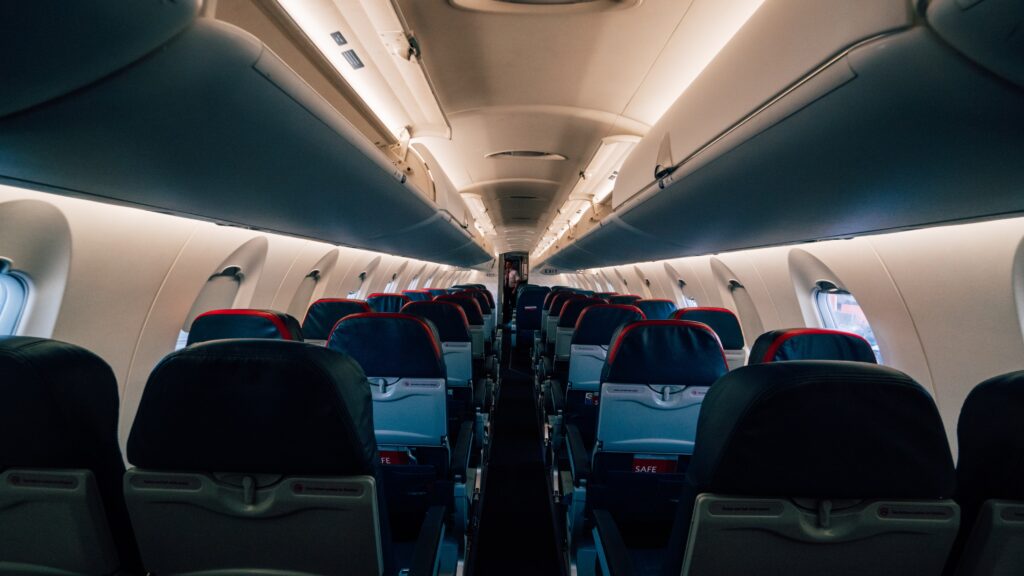The Class of comfort and Etiquette
Air travel has merged seamlessly into our lives in today’s fast-paced society. For our personal comfort and the consideration of other passengers, we must retain a sense of calm and decency as we navigate busy terminals and board aeroplanes. This is especially crucial when travelling with kids because of the special problems that their needs and behaviours can offer.
Flying with a child can be a special and fulfilling experience, but it requires considerate planning and effort. There are several parts of travel etiquette that are helpful, from seeing out for the safety and comfort of the child to looking out for your fellow travellers. We’ll talk about comfort and decorum when it comes to flying with kids in this conversation.
The comfort of the child is a top priority when travelling with them. Airlines are aware of this and frequently provide extra services and amenities to accommodate families travelling with young children. In instance, business class offers superior comfort amenities like increased legroom, lie-flat chairs, and individualised service from the cabin crew. To balance your child’s comfort with the inconvenience it causes other passengers, nevertheless, is vital.

While infants can be unpredictable and may fuss or cry during the journey, there are measures you can do to assure their comfort and lessen any disruptions for other passengers. When designing an advance plan, it is important to evaluate the baby’s eating and sleeping schedules as well as any essentials like diapers, toys, or pacifiers. Being preparation can help you create a supportive environment that will boost your child’s wellbeing to minimise potential of discomfort.
When it comes to good travel manners, looking out for your fellow travellers is crucial. It is best to let the airline know in advance that you are taking a youngster since they can offer extra assistance or make the appropriate accommodations. Try to be mindful of your child’s volume while aboard, especially during times of relative silence like takeoffs, landings, or when others are attempting to sleep. If you want to keep your kid occupied, think about giving them noise-canceling headphones or doing quiet activities.
Respect the cabin’s restricted space as well. Don’t allow your child to access other people’s chairs or use them as storage. To prevent pain for you and other people, keep your possessions arranged and sufficiently separated. Keep in mind that having a nice and cooperative attitude can greatly contribute to creating a favourable atmosphere during the flight.
Finally, flying with a youngster necessitates striking a careful balance between making sure they’re comfortable and showing consideration for other passengers. You may create a peaceful atmosphere that caters to the requirements of your child and others around you by organising ahead, being ready, and following proper travel protocol. Always keep in mind that everyone may enjoy the experience with a little bit of patience and understanding.
Baby In Business Class
The Pros and Cons of Allowing Babies in Business Class
The following are some possible benefits and drawbacks of admitting infants in business class:
Baby In Business Class Pros:-
Allowing babies in business class provides families with more inclusive travel options. It allows parents to travel with their infants comfortably and conveniently, ensuring that families can stay together during their journey. This inclusivity is particularly beneficial for parents who may need the additional space, amenities, and services provided in business class when travelling with a baby.
Business class passengers may find the extensive selection of amenities and services especially useful if they are travelling with young children. Better seating, more legroom, larger seats that may recline into a flat position, and additional storage for baby essentials like diapers, bottles, and strollers are frequently included in such modifications.
Parents may find it simple to care for their infants while the ship is moving, including feeding, changing diapers, and lulling them to sleep, despite the abundance of accommodations and comfort.
Allowing babies in business class promotes a family-friendly environment onboard the aircraft. It recognizes that families with infants deserve to travel comfortably and without judgment. By welcoming babies in business class, airlines send a positive message that families are valued customers and their needs are taken into consideration. This can create a more inclusive and accepting atmosphere for families traveling with infants, reducing stress and anxiety for both parents and fellow passengers.
Baby In Business Class Cons:-
Disruption to other passengers: Business class is often chosen by travelers seeking a quiet and premium experience during their flight. Babies, especially if they become fussy or cry, can disturb the peaceful atmosphere that other passengers expect. This can lead to discomfort and frustration among those who have paid a premium for their seats.
Limited availability for non-family travelers: Business class seats are in high demand, and many passengers pay a significant amount to enjoy the added comfort and amenities. Allowing babies in business class may reduce the availability of these seats for non-family travelers who are willing to pay for the experience. This can lead to disappointment for those who value the exclusivity and luxury of business class.
Management of crying or restless babies: Babies, particularly during long-haul flights, may experience discomfort, restlessness, or have bouts of crying. Managing such situations can be challenging for both the parents and the airline staff. Business class passengers expect a peaceful and relaxing journey, and the presence of crying babies can detract from that experience.
It is worth noting that some airlines have introduced measures to address these concerns, such as providing designated areas or baby-friendly zones on the plane. These zones offer more space and amenities to accommodate families with babies, while also considering the needs and expectations of other passengers in business class.
It’s crucial to remember that each airline may have its own rules regulating the presence of infants in business class, so it’s best to inquire about these before booking.

The Moral Dilemma: Balancing Personal Preferences and Social Responsibility
The moral dilemma of balancing personal preferences and social responsibility requires empathy for travel etiquette parents and children, as well as finding agreements that respect both our own preferences and the well-being of others. This includes being considerate and respectful of others, controlling noise levels, and avoiding disruptive behaviors. Empathy can avoid entitlement as well as create a more inclusive and harmonious travel environment. Open dialogue and negotiation can help reach a mutually agreeable solution. By being mindful of our actions, showing empathy, and seeking compromise, we can overcome this dilemma and promote a more harmonious and thoughtful travel experience for all involved.
Evaluating the Perspectives: AITA (Am I The Asshole) Analysis
To comprehend the dynamics of a scenario in AITA conversations, it is crucial to consider several points of view. Identifying the key players, examining the OP’s perspective, taking into account the viewpoints of other parties, obtaining additional information, assessing social norms and expectations, examining potential biases, balancing the points of view, and developing an assessment are all part of this process. Insight, counsel, and the encouragement of self-reflection are the objectives rather than making judgements about specific people. Discussions that are civil and considerate of both parties’ needs can advance mutual understanding and personal development.
Examining the OP’s point of view, taking into account the points of view of other parties, gathering more data, assessing social norms and expectations, and weighting the points of view all contribute to a more balanced perspective.
Navigating Solutions: Finding Middle Ground & Potential Alternatives
When it comes to finding middle ground and potential alternatives in navigating solutions, airlines have a responsibility in managing customer expectations, particularly in scenarios involving designated baby-free sections or flights that cater to family-friendly travel options. By considering the needs and preferences of different passengers, airlines can work towards compromise and ensure a more pleasant travel experience for everyone involved.

One potential solution is the implementation of designated baby-free sections on flights. This concept involves allocating specific areas on the aircraft where passengers traveling without infants or young children can sit. This allows individuals seeking a quieter and more peaceful environment to have the option of avoiding disruptions caused by infants or children during the flight. Passengers who prefer a child-free space can choose these designated sections when booking their tickets, and families traveling with infants or young children can opt for other sections of the aircraft. This approach acknowledges the diverse needs of passengers while providing a compromise that respects both sides.
Additionally, airlines can explore family-friendly travel options to accommodate passengers with children. This could include offering flights specifically tailored to families, where amenities and services are provided to create a more comfortable and engaging experience for children. Airlines could consider providing dedicated play areas, entertainment options, or child-friendly meals on these flights. By creating an environment that caters to families, airlines can reduce the potential for conflicts or inconveniences between passengers who may have different expectations during travel.
It is important for airlines to communicate and manage customer expectations effectively. Clear information should be provided during the booking process, indicating the availability of designated baby-free sections or family-friendly flights. This way, passengers can make informed decisions and choose options that align with their preferences. Transparent communication about the policies and procedures regarding child-related matters can help set realistic expectations and minimize misunderstandings or dissatisfaction.
Furthermore, airlines should actively seek feedback from their customers and take their concerns into consideration. Regularly evaluating and adjusting the designated baby-free sections or family-friendly offerings based on customer feedback can lead to continuous improvement and better customer satisfaction. This iterative approach allows airlines to refine their solutions over time, ensuring they are effective and align with the needs of their diverse passenger base.
In summary, airlines can navigate solutions by implementing designated baby-free sections, exploring family-friendly travel options, managing customer expectations through transparent communication, and incorporating feedback from passengers. By finding middle ground and considering the preferences of different travelers, airlines can create a more inclusive and accommodating travel experience for everyone.
Conclusion: Striking a Balance for a Happier Flight Experience
striking a balance is essential for creating a happier flight experience for all passengers. Respecting the needs and preferences of different individuals on the plane and finding compromises can go a long way in promoting empathy and understanding among travelers. By considering the following factors, airlines and passengers can contribute to a more harmonious and enjoyable journey:
Communication: Encouraging open and respectful communication between passengers and airline staff can help address concerns and find solutions. Clear communication channels can enable passengers to express their needs and preferences, while airlines can provide necessary information and updates.
Seat arrangements: Airlines can consider offering a variety of seating options to accommodate different passenger preferences. This may include designated quiet zones for those who prefer a more serene environment or family-friendly sections for travelers with young children.
Noise control: Encouraging passengers to use headphones when watching movies, listening to music, or engaging in other activities that may produce sound can minimize disturbances to fellow travelers. Additionally, flight attendants can play a role in politely addressing excessive noise and reminding passengers to be considerate.
Personal space: Respect for personal space is crucial for a positive flight experience. Airlines can ensure that seats are adequately spaced, allowing passengers to have comfortable legroom. Passengers should also be mindful of their actions and avoid encroaching on the space of others.

Service quality: Airlines should strive to provide excellent service and address passenger needs promptly and courteously. Attentive and friendly flight attendants can contribute significantly to a more positive and relaxed atmosphere onboard.
Etiquette and patience: Passengers can play their part by practicing good etiquette, such as using headphones, avoiding excessive reclining of seats, and being mindful of their volume during conversations.A more peaceful atmosphere on the flight can be achieved with patience and understanding.
Offering an extensive choice of in-flight entertainment alternative solutions helps accommodate various preferences and let passengers’ time pass peacefully. Broadly attracting multimedia such as music, television shows, movies, and video games might come under this classification.
Airlines and passengers are able to communicate to create a happier flight experience by executing these strategies into effect and promoting a culture of gratitude and compassion. Remember, a little empathy and compromise can make a significant difference in ensuring that everyone enjoys their journey.


